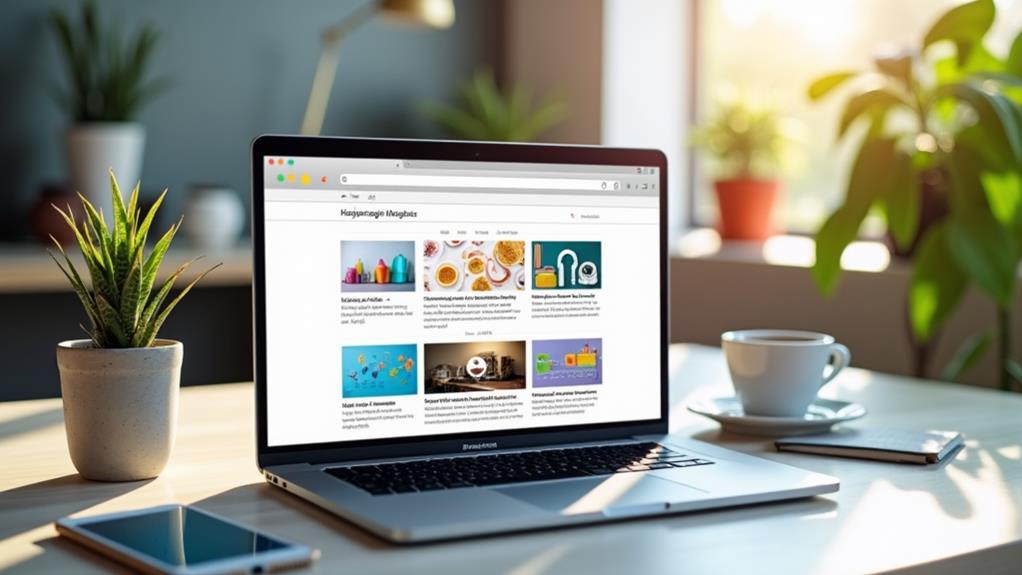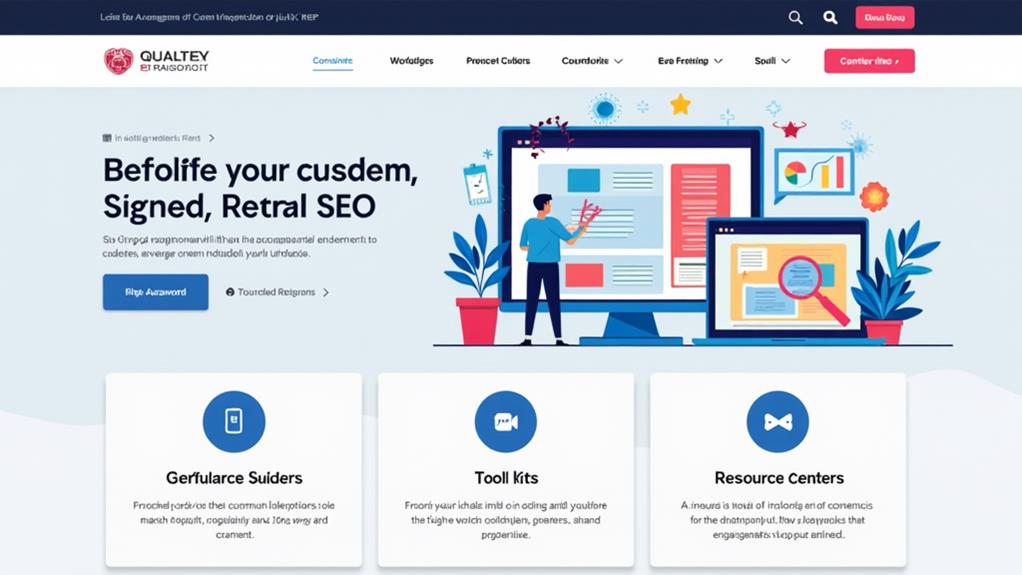
Driving traffic to your blog using SEO requires a strategic approach centered on quality content and keywords. Create long-form and evergreen content to attract backlinks and social shares. Master SEO fundamentals by optimizing title tags, meta descriptions, and headers while targeting high-impact, long-tail keywords. Regularly update content and integrate engaging visuals and videos to enhance user experience. Collaborate for guest blogging and acquire high-authority backlinks. Speed up your site to improve user retention, and promote your content on social media and through email marketing. Properly implementing these techniques will greatly enhance your blog's visibility and traffic. Discover the full potential by continuing on.
Key Takeaways
- Consistently create high-quality, long-form content to attract and retain visitors.
- Optimize on-page SEO elements like title tags, meta descriptions, and headers.
- Utilize long-tail keywords to target specific search intents and boost conversion rates.
- Leverage images and videos to enhance engagement and improve organic traffic.
- Implement a robust backlink strategy by guest blogging and collaborating with high-authority sites.
Quality Content Creation
Crafting quality content is a cornerstone of effective SEO strategy, as engaging and informative posts are essential in attracting and retaining visitors, thus considerably enhancing website traffic.
Content curation plays a critical role in this process; selecting and organizing high-value information not only increases audience engagement but also reinforces the relevance and authority of your website. Companies that prioritize consistent content creation see a 97% increase in links to their sites, underscoring the notable impact of well-curated content on SEO and visibility.
Additionally, regular updates to the portfolio guarantee sustained interest and relevance, which is key for long-term success.
Long-form content, often exceeding 3,000 words, is particularly effective, garnering 56% more social media shares and ranking for a broader range of keywords. This approach not only boosts organic traffic but also enhances audience engagement by providing thorough and in-depth information.
Evergreen content further amplifies these benefits, as its enduring relevance guarantees consistent traffic influx and backlink accumulation, essential for sustained SEO performance.
Additionally, regularly updating and revitalizing existing posts can greatly improve their search result rankings. Google's algorithm favors fresh content, which can lead to sustained audience engagement over time.
Consequently, strategic content curation and periodic updates are indispensable for maintaining a robust and effective SEO strategy.
Establish a Business Blog
To capitalize on the benefits of quality content creation, establishing a business blog is a strategic move that greatly amplifies your SEO efforts. Companies that maintain a blog receive 97% more links to their sites compared to those that do not, markedly enhancing their online visibility and authority. In addition, blogging benefits extend to a 55% increase in website visitors, making it an essential component of a robust content strategy.
| Metric | Impact |
|---|---|
| Links Received | 97% increase |
| Website Visitors | 55% increase |
| Positive ROI | 13 times more likely |
| Long-term Traffic Growth | Sustained through long-form content |
A well-structured business blog allows marketers to explore diverse topics, fostering deeper audience engagement and connection through valuable, relevant content. Marketers who actively blog are 13 times more likely to see a positive ROI, underscoring the financial advantages of a strong content strategy. Regularly publishing long-form content not only builds authority and trust but also contributes to sustained traffic growth over time.
Master SEO Fundamentals
Understanding the core principles of SEO is paramount for driving considerable traffic to your blog. Mastering SEO fundamentals involves a strategic approach to keyword research, on-page SEO, and content optimization. By focusing on keyword trends and understanding search algorithms, you can notably enhance your blog's visibility and attract a larger audience.
1. Keyword Research: Target high-traffic, low-competition keywords to improve visibility. Effective strategies can lead to an increase of up to 36K visits per month, as demonstrated by sites like the Humane Society of the United States.
Utilize tools like Ahrefs for insights and competition analysis to fine-tune your keyword targeting.
2. On-Page SEO: Optimize title tags, meta descriptions, and headers with relevant keywords. This guarantees search engines accurately interpret your content, improving organic search rankings.
3. Long-Tail Keywords: Incorporate these in your content to attract more relevant traffic. Their specific nature often results in higher conversion rates, making your blog more effective.
4. Content Updates: Regularly update and optimize older content to signal activity to search engines. Fresh content can improve rankings and maintain visitor engagement over time.
Utilizing tools like Google Analytics and Semrush can provide valuable insights into your SEO performance, helping you track keyword rankings and identify content gaps for strategic optimization.
Develop a Keyword Strategy
To effectively drive traffic to your blog, implementing a robust keyword strategy is essential.
Emphasizing the benefits of long-tail keywords can enhance your search rankings and conversion rates, while strategic keyword placement in titles, meta descriptions, and headers amplifies on-page SEO.
Leveraging tools like SEMrush and Ahrefs for extensive keyword research and competitor analysis can provide valuable insights.
Balancing keyword variety guarantees thorough content coverage, attracting diverse search queries and sustaining audience engagement.
Long-Tail Keyword Benefits
Developing a strategic keyword plan centered around long-tail keywords can greatly enhance your blog's SEO performance. Long-tail keyword research reveals that these phrases, typically three or more words long, are easier to rank for in search engine results compared to broader keywords. This is because they face less competition and better align with specific search intents, thereby driving more relevant traffic to your blog.
Utilizing long-tail keyword tools like Google Keyword Planner or Ubersuggest can help you identify effective long-tail keywords that match your audience's search behavior. Incorporating these keywords into your content strategy offers several advantages:
- Higher Conversion Rates: Because long-tail keywords target specific search intents, they have a higher conversion rate, bringing in users who are more likely to engage with your content.
- Increased Visibility: Long-tail keywords account for approximately 70% of all search queries, making them integral to improving your blog's visibility.
- Lower Competition: These keywords often face less competition than short-tail keywords, making it easier to rank higher in search results.
- Enhanced Content Optimization: Long-tail keyword optimization can lead to better overall SEO performance, driving higher organic traffic to your blog.
Keyword Placement Tips
Building on the benefits of long-tail keywords, the strategic placement of these keywords within your blog content is paramount to maximizing SEO effectiveness. Strategic keyword placement involves embedding your target keywords in critical areas such as title tags, meta descriptions, headings, and throughout the body text. This practice enhances search engine visibility and semantic relevance, ensuring your content is easily discoverable.
To optimize keyword density without overstuffing, distribute primary and secondary keywords naturally throughout the text. Tools like Google Keyword Planner or Semrush can identify high-traffic, low-competition keywords, guiding your placement strategy. Long-tail keywords, being more specific and less competitive, should be incorporated into metadata and body text to improve rankings and attract targeted traffic, often resulting in higher conversion rates.
Regularly updating metadata, including title tags and meta descriptions, to reflect content changes or new target keywords can greatly boost visibility and click-through rates in SERPs. Ensuring that primary keywords are placed in headings enhances semantic relevance, allowing search engines to understand the context better.
Balancing Keyword Variety
In the domain of SEO, a balanced keyword strategy is vital for driving sustainable traffic to your blog. To achieve this, integrating a mix of high-volume keywords and long-tail keywords is fundamental. Long-tail keywords, in particular, are easier to rank for and often lead to higher conversion rates due to their specificity.
To develop an effective keyword strategy, consider the following steps:
- Conduct Keyword Research: Utilize tools like Semrush to identify high-traffic keywords and their competition levels. This allows you to align your content effectively with audience needs and optimize for keyword clustering.
- Incorporate Keywords: Integrate your target keywords into title tags, meta descriptions, and headers. This enhances SEO effectiveness and improves search engine visibility.
- Update Regularly: Regularly analyze performance metrics to adapt your keyword strategy. This helps you stay relevant in search results and catch emerging trends, including seasonal keywords.
- Utilize Long-Tail Keywords: Focus on long-tail keywords to capture more specific search queries. This drives targeted traffic to your blog, improving engagement and conversion rates.
Balancing keyword variety through strategic planning and data-driven analysis guarantees your blog remains competitive and attracts a steady stream of visitors.
Leverage Visual and Video Content

Incorporating optimized visual and video content into your blog is a strategic approach to enhance engagement and drive traffic.
Blog posts featuring images can achieve up to 94% more views, and embedding videos can capitalize on the 77% of internet users aged 15-35 who frequent YouTube, thereby improving user interaction and retention.
Additionally, Google's preference for image-rich content in search results underscores the importance of relevant visuals and SEO-optimized video titles and descriptions for boosting organic traffic.
Leveraging high-quality food imagery from food photography can greatly enhance your visual appeal and engage the growing foodie culture.
Optimize Visual Content
Boosting your blog's engagement and visibility can be strategically achieved by optimizing visual content. Image optimization and incorporating compelling video thumbnails are vital elements in this process. Research indicates that articles containing relevant images receive 94% more views than those without, highlighting the importance of visual content in attracting blog visitors.
Here are four key strategies to optimize visual content effectively:
- Image Optimization: Make certain that all images are high-quality, appropriately sized, and compressed to enhance load times. Use descriptive file names and alt tags to improve search engine indexing.
- Infographics: Utilize tools like Canva to create visually appealing infographics that simplify complex information. These graphics are more accessible and shareable, boosting engagement and visibility.
- Video Thumbnails: Design compelling video thumbnails that entice viewers to click and watch. Effective thumbnails can greatly increase visitor engagement, driving more traffic to your blog.
- Embedding Videos: Embed relevant videos within your blog posts to enhance user experience and improve search visibility. Optimized video content can attract traffic from platforms like YouTube, further expanding your audience reach.
Engage With Videos
Engaging with videos is a powerful strategy that can greatly improve your blog's visibility and user engagement. Video marketing has proven to be remarkably effective, with research showing that videos generate 1200% more shares than text-based content alone. This higher share rate can dramatically extend your reach, drawing more visitors to your blog.
Google's search algorithms favor content that includes rich media, and incorporating videos can boost your SEO rankings. This increased visibility on search engines translates to more organic traffic to your blog.
Additionally, video content can considerably improve audience retention by increasing the average time users spend on your page. This extended engagement is a critical factor in lowering bounce rates, which further enhances your search rankings.
Utilizing YouTube, the second-largest search engine, can also drive considerable traffic to your blog. By optimizing your video content with relevant keywords and including links back to your site, you can attract a broader audience.
Furthermore, embedding call-to-action buttons within your videos can direct viewers to your blog, encouraging deeper exploration of your content. Implementing these strategic video marketing techniques can remarkably enhance your blog's performance and audience retention.
Guest Blogging and Collaborations
Guest blogging and collaborations often serve as a robust strategy for driving traffic to your blog, mainly due to their multifaceted benefits.
By engaging in guest post outreach and establishing influencer partnerships, you can greatly enhance your blog's visibility and authority. According to recent data, guest blogging can lead to a 97% increase in backlinks, which is vital for improving your blog's search engine rankings.
Additionally, collaborating with other writers and thought leaders expands your reach and opens doors to higher-paying opportunities. For example, by focusing on niche-specific samples, you can attract targeted clients and boost your blog's credibility.
Here are four key benefits of guest blogging and collaborations:
- Enhanced Backlinks: Guest blogging can lead to a 97% increase in backlinks, greatly improving your blog's authority and search engine visibility.
- Expanded Audience Reach: Collaborating with high-authority sites can attract 55% more visitors to your blog, broadening your audience base.
- Improved Credibility: Quality guest content and influencer partnerships boost your blog's credibility, leading to higher traffic and engagement.
- Valuable Insights: Guest blogging provides insights into competitor strategies, helping you identify trending topics and effective content approaches.
Build Resource Centers

Creating a resource center is a strategic approach to aggregate educational resources such as infographics, guides, and webinars, thereby enhancing content discoverability and establishing niche authority.
For example, interactive tools like calculators and quizzes can be included to boost engagement and provide personalized experiences for users. This centralized hub encourages repeat visits by addressing diverse audience needs, greatly improving retention rates.
Additionally, regularly updating the resource center with fresh, high-quality content can boost SEO performance, attract consistent traffic, and generate valuable backlinks.
Aggregate Educational Resources
Building an extensive resource center on your blog can greatly enhance its educational value while driving consistent traffic through effective SEO strategies. By aggregating various resource types, such as infographics, guides, and webinars, you can notably boost user engagement and establish your blog as an authoritative source within your niche.
Here's a strategic approach to maximize the impact of your resource center:
- Diversify Content Formats: Offer a wide range of educational materials like downloadable PDFs, interactive tools, and video tutorials to cater to different learning preferences and increase overall user engagement.
- Regular Updates: Consistently update your resources to make certain they remain relevant and valuable. Search engines favor fresh content, which can enhance your SEO performance and drive more traffic.
- Centralized Information: Aggregate all educational materials in a well-organized, easy-to-navigate resource center. This approach helps establish trust and authority, making your blog a go-to destination for thorough information.
- Promotion: Utilize social media and email marketing to promote your resource center. This not only boosts visibility but also drives more visitors to your blog, further reinforcing its educational value.
Strategically planning and maintaining a resource center can lead to sustained traffic growth and heightened user engagement, essential for long-term SEO success.
Enhance Content Discoverability
Enhancing content discoverability through a strategically planned resource center is a vital step in driving sustained traffic to your blog. By focusing on content curation, you can aggregate diverse content types such as infographics, guides, and webinars, which collectively enhance the educational value of your site.
This centralized approach not only facilitates audience segmentation but also establishes your blog as a trusted authority within your niche, thereby increasing engagement and return traffic.
Regularly updating your resource center with fresh content is essential for improving SEO rankings, as search engines prioritize sites that consistently provide valuable information. Incorporating a variety of content formats, such as videos and downloadable materials, caters to the diverse preferences of your audience, further boosting overall site traffic.
To maximize visibility, promote your resource center through social media channels and email newsletters. This not only drives more visitors to your blog but also increases the likelihood of earning backlinks from other reputable sites.
A well-maintained resource center serves as a thorough hub of valuable information, enhancing content discoverability and ensuring sustained traffic growth through strategic content curation and effective audience segmentation.
Encourage Repeat Visits
A resource center serves as a fundamental element in encouraging repeat visits to your blog. By aggregating various content types such as infographics, guides, and webinars, you can enhance educational value and foster user engagement. Here are strategic steps to build an effective resource center:
- Content Variety: Incorporate diverse formats like videos, podcasts, and articles to cater to different audience preferences and facilitate content curation.
- Interactive Elements: Utilize quizzes, surveys, and forums to boost community involvement and gather valuable user feedback.
- Personalization and Segmentation: Tailor content recommendations based on audience segmentation to increase relevance and engagement.
- Loyalty Programs: Implement loyalty programs that reward users for frequent visits and content interaction, fostering long-term engagement.
A well-organized resource center not only establishes trust but also positions your blog as an authority in your niche. Regular updates are essential; websites with fresh content attract 50% more repeat visitors.
Additionally, integrating user-generated content can greatly impact engagement, as it resonates more with 79% of consumers. Promoting your resource center through targeted promotions, email newsletters, and social media will enhance visibility.
Engaging content in newsletters, for instance, boosts click-through rates by 2-5 times, making them an effective tool for driving traffic.
Utilize Social Media
Leveraging social media platforms is a powerful strategy for driving traffic to your blog, thanks to their vast user bases and dynamic engagement opportunities. Developing a robust social media strategy involves tailoring your content to fit the unique characteristics of each platform. For example, utilizing eye-catching visuals on Instagram can greatly boost audience engagement.
Studies indicate that tailored social media posts can drive more traffic than traditional email newsletters. Incorporating relevant hashtags into your posts can further enhance discoverability. Data shows that using hashtags can increase engagement by up to 30%, making it easier for users to find and interact with your content.
Utilizing tools like Hootsuite or Buffer can streamline post scheduling and consistency, ensuring ideal timing for posts to maximize audience engagement. Engaging actively with your audience through comments and direct messages fosters a sense of community, encouraging users to visit your blog for more in-depth content.
Collaborations with influencers offer another strategic advantage. By partnering with influencers, you can tap into their follower base, introducing your blog to a broader and more targeted audience. This approach not only expands your reach but also drives higher quality traffic to your blog, as influencer endorsements are often trusted by their followers.
Adopting these social media strategies can greatly enhance your blog's visibility and traffic.
Implement Backlink Strategies

Building a robust backlink strategy is vital for elevating your blog's search engine rankings and driving substantial organic traffic. Backlinks from high Domain Authority (DA) sites are imperative, as Google views them as a vote of confidence in your content.
Effective link building can be achieved through several strategic initiatives, including leveraging SEO strategies and engaging with reputable communities to foster trust.
1. Backlink Outreach and Competitor Analysis: Utilize tools like Ahrefs or SEMrush to analyze your competitors' backlink profiles. Identify opportunities where you can secure similar backlinks, and perform targeted backlink outreach to those sites.
2. Guest Post Guidelines: Writing guest posts on reputable blogs allows you to earn high-quality backlinks while reaching new audiences. Guarantee your content adheres to the host site's guest post guidelines for maximum acceptance.
3. Link Reclamation and Resource Pages: Identify broken links on high DA sites using tools like Ahrefs. Offer your content as a replacement, thereby reclaiming valuable backlinks.
Additionally, get your blog featured on relevant resource pages.
4. Influencer Partnerships and Content Syndication: Engage in collaborative content efforts, such as co-authored articles or interviews with influencers.
Content syndication on platforms with high DA can also amplify your reach and backlink profile.
Enhance Page Speed
Page speed greatly influences user experience and SEO performance, making it an essential aspect of strategic blog optimization. Google has emphasized that a one-second delay in load time can result in a 7% reduction in conversions. This underscores the importance of fast-loading pages, as 53% of mobile users abandon sites taking more than three seconds to load.
Additionally, leveraging financial tools to track and manage expenses can indirectly support the resources needed for optimizing technical aspects like page speed.
To enhance page speed, image optimization is essential. Compressing images without compromising quality can greatly reduce load times. Tools like Google PageSpeed Insights offer valuable recommendations for optimizing images, ensuring faster page rendering and improved user engagement.
Cache management is another critical strategy. Leveraging browser caching allows repeated visitors to access stored resources, reducing load times and server strain. This can be implemented through proper HTTP header configuration, resulting in faster page loads and better user retention.
Minimizing HTTP requests also contributes to faster load times. Reducing the number of elements on a page, such as scripts and stylesheets, can lead to a more efficient loading process.
Websites loading in less than two seconds have an average conversion rate of 5.31%, compared to just 2.07% for those taking five seconds or longer, highlighting the direct impact of page speed on conversions.
Promote Your Content

Promoting your content is an essential step in driving traffic to your blog and ensuring that your hard work reaches a broader audience. Strategic promotion leverages various channels to maximize exposure and engagement. Here are some key tactics:
1. Email Marketing and Newsletter Strategy: Use audience segmentation to tailor your newsletter strategy, ensuring that each email is relevant and valuable. Data shows that email marketing can outperform social media, driving more visitors with targeted campaigns.
Incorporating AI-driven content creation into your email strategy can further enhance engagement by delivering highly personalized messages.
2. Social Sharing and Visual Storytelling: Utilize platforms like Pinterest for social sharing, focusing on visual storytelling to attract engagement. Infographic design is particularly effective, as high-quality visuals simplify complex data and often lead to increased backlinks and traffic.
3. Influencer Outreach and Collaboration: Partnering with influencers in your niche can introduce your content to new, targeted audiences. Authentic influencer outreach enhances credibility and trust, making it a strategic component of your promotional efforts.
4. Community Engagement and Forum Participation: Engage in online communities and participate in forums related to your niche. This targeted approach not only establishes your authority but also attracts readers who are genuinely interested in your content.
Optimize Internal Linking
Although often overlooked, optimizing internal linking is an essential component of an effective SEO strategy. Internal linking enhances site navigation and keeps visitors engaged longer, potentially leading to a 50% increase in page views per session. By strategically linking to relevant blog posts within your content, you can improve the overall authority of your website.
Google considers internal links when evaluating your site's structure and link relevance, thus boosting your SEO performance.
Using descriptive anchor text for internal links is important as it provides context for search engines. This approach clearly defines the relationship between the linked content, making it easier for search engines to understand and prioritize your pages.
Regularly auditing and updating internal links guarantees they remain relevant and functional, reducing bounce rates and enhancing user experience.
A well-planned internal linking strategy can lead to a 40% increase in the ranking potential of your blog posts. This is achieved by effectively distributing link equity throughout your site.
As a result, integrating a robust internal linking framework not only improves navigation and user engagement but also greatly enhances your blog's SEO performance and visibility.
Frequently Asked Questions
How Can I Increase My Blog Traffic SEO?
To increase your blog traffic through SEO, conduct thorough keyword research and focus on content optimization. Utilize strategic planning by incorporating high-traffic keywords, crafting long-form content, and regularly updating evergreen posts to enhance organic visibility and user engagement.
How to Drive Traffic With SEO?
Driving traffic with SEO requires strategic planning, including thorough keyword research and meticulous content optimization. Regularly update evergreen content and utilize analytics tools to refine strategies, ensuring consistent organic growth and improved search engine rankings.
How Can I Do SEO for My Blog?
To effectively perform SEO for your blog, start with extensive keyword research to identify relevant terms. Implement content optimization by strategically placing these keywords in titles, meta descriptions, headers, and content, ensuring data-driven and strategic planning.
How You Can Generate Traffic to Your Website Through Off-Page SEO?
Generating traffic through off-page SEO involves strategic planning, including backlink building from authoritative sites and leveraging social sharing to amplify reach. These tactics enhance your blog's visibility, improve search engine rankings, and drive targeted, organic traffic.
Conclusion
In summary, driving traffic to a blog through SEO involves a multi-faceted approach that includes quality content creation, establishing a business blog, mastering SEO fundamentals, and developing a keyword strategy. Additionally, leveraging visual and video content, implementing backlink strategies, enhancing page speed, promoting content, and optimizing internal linking are critical components. Utilizing these data-driven and strategic planning techniques guarantees sustained visibility and engagement, ultimately leading to increased traffic and successful blog performance.
Leave a Reply